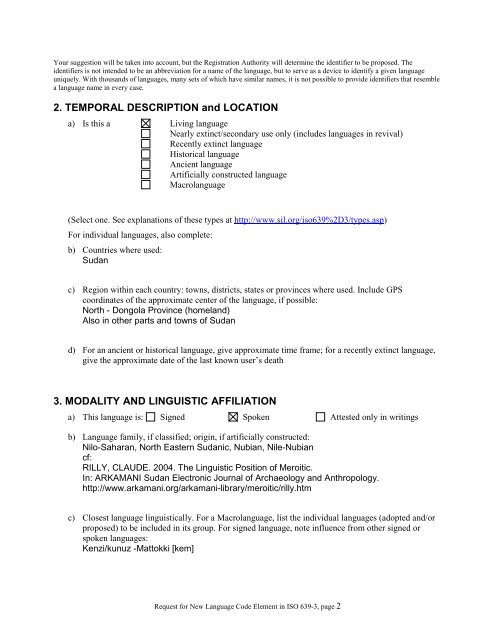ISO 639-3 Registration Authority Request for New ... - SIL International
ISO 639-3 Registration Authority Request for New ... - SIL International
ISO 639-3 Registration Authority Request for New ... - SIL International
Create successful ePaper yourself
Turn your PDF publications into a flip-book with our unique Google optimized e-Paper software.
Your suggestion will be taken into account, but the <strong>Registration</strong> <strong>Authority</strong> will determine the identifier to be proposed. The<br />
identifiers is not intended to be an abbreviation <strong>for</strong> a name of the language, but to serve as a device to identify a given language<br />
uniquely. With thousands of languages, many sets of which have similar names, it is not possible to provide identifiers that resemble<br />
a language name in every case.<br />
2. TEMPORAL DESCRIPTION and LOCATION<br />
a) Is this a Living language<br />
Nearly extinct/secondary use only (includes languages in revival)<br />
Recently extinct language<br />
Historical language<br />
Ancient language<br />
Artificially constructed language<br />
Macrolanguage<br />
(Select one. See explanations of these types at http://www.sil.org/iso<strong>639</strong>%2D3/types.asp)<br />
For individual languages, also complete:<br />
b) Countries where used:<br />
Sudan<br />
c) Region within each country: towns, districts, states or provinces where used. Include GPS<br />
coordinates of the approximate center of the language, if possible:<br />
North - Dongola Province (homeland)<br />
Also in other parts and towns of Sudan<br />
d) For an ancient or historical language, give approximate time frame; <strong>for</strong> a recently extinct language,<br />
give the approximate date of the last known user’s death<br />
3. MODALITY AND LINGUISTIC AFFILIATION<br />
a) This language is: Signed Spoken Attested only in writings<br />
b) Language family, if classified; origin, if artificially constructed:<br />
Nilo-Saharan, North Eastern Sudanic, Nubian, Nile-Nubian<br />
cf:<br />
RILLY, CLAUDE. 2004. The Linguistic Position of Meroitic.<br />
In: ARKAMANI Sudan Electronic Journal of Archaeology and Anthropology.<br />
http://www.arkamani.org/arkamani-library/meroitic/rilly.htm<br />
c) Closest language linguistically. For a Macrolanguage, list the individual languages (adopted and/or<br />
proposed) to be included in its group. For signed language, note influence from other signed or<br />
spoken languages:<br />
Kenzi/kunuz -Mattokki [kem]<br />
<strong>Request</strong> <strong>for</strong> <strong>New</strong> Language Code Element in <strong>ISO</strong> <strong>639</strong>-3, page 2
















